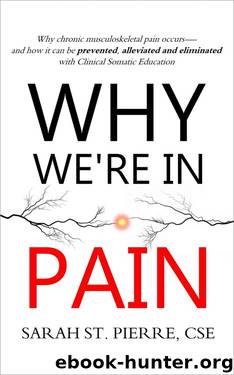Why We're in Pain: Why Chronic Musculoskeletal Pain Occurs - and How It Can Be Prevented, Alleviated and Eliminated With Clinical Somatic Education by Sarah St. Pierre

Author:Sarah St. Pierre [Pierre, Sarah St.]
Language: eng
Format: epub
Tags: Health; Fitness & Dieting, Diseases & Physical Ailments, Pain Management, Thomas Hanna, chronic pain treatment, hanna somatics, somatic education, chronic pain, somatics, clinical somatics
Amazon: B00SOXN1YM
Publisher: Next Phase Health
Published: 2015-01-22T22:00:00+00:00
Elsa Gindler
Elsa Gindler was born in 1885 to a working class family in Berlin, Germany. As a young woman she suffered from consumption, known today as tuberculosis. Her doctor recommended a period of rest in Switzerland during which her affected lung could heal. Gindler could not afford such an expensive treatment, so she decided to try to rest her infected lung by using only her healthy lung to breathe. By paying close attention to her internal sensations, she gradually gained control of all the muscles involved in breathing into each lung independently.
As Gindler's health improved, her doctor called it a miracle, refusing to believe that such self-healing was possible. Like Alexander, Gindler had healed herself by focusing her attention inward and teaching herself to gain control of her physiological functioning.
Gindler became a physical education teacher, teaching a technique developed by Hedwig Kallmeyer called Harmonische Gymnastik. After some years of teaching this method she began to find it limiting, and she started to explore how to guide people through independent exploration of their sensory awareness. She stopped using the word “exercise” and began calling her movements “experiments.”
Gindler asked her students to focus their attention completely on their internal sensations as they moved. She understood the principles of attention and awareness, in that the more conscious attention we pay to a part of our body, the greater sensation and motor control we develop. As their sensory awareness and motor control improved, Gindler's students experienced profound changes in their health and functioning.
Around 1924, Gindler met Heinrich Jacoby, a musician and educator who had a passion for psychoanalysis. The two studied together and collaborated on work which combined sensory exploration and psychotherapy. Sadly, they were forced to part ways when the Nazi regime took power in 1933. Jacoby left Germany for Switzerland, where he continued his work. Gindler stayed in Berlin, teaching her methods and providing shelter to those who were being persecuted for being of the Jewish faith.
Gindler did not wish to offer professional training in her methods; she simply wanted to do research and lead people through explorations in small study groups. Luckily, Gindler's students traveled and spread knowledge of her work. Most notably, her student Charlotte Selver emigrated to the United States and introduced Gindler's work under the name “Sensory Awareness.” Selver and Gindler's other students influenced the work of many somatic educators and psychotherapists, including Erich Fromm, Fritz Perls, Alan Watts, Marion Rosen, Mary Wigman, Peter Levine and Wilhelm Reich.
Download
This site does not store any files on its server. We only index and link to content provided by other sites. Please contact the content providers to delete copyright contents if any and email us, we'll remove relevant links or contents immediately.
Men In Love by Nancy Friday(5156)
Everything Happens for a Reason by Kate Bowler(4679)
The Immortal Life of Henrietta Lacks by Rebecca Skloot(4525)
Why We Sleep by Matthew Walker(4360)
The Sports Rules Book by Human Kinetics(4294)
Not a Diet Book by James Smith(3336)
The Emperor of All Maladies: A Biography of Cancer by Siddhartha Mukherjee(3066)
Sapiens and Homo Deus by Yuval Noah Harari(2987)
Day by Elie Wiesel(2720)
Angels in America by Tony Kushner(2596)
A Burst of Light by Audre Lorde(2546)
Endless Forms Most Beautiful by Sean B. Carroll(2431)
Hashimoto's Protocol by Izabella Wentz PharmD(2331)
Dirty Genes by Ben Lynch(2272)
Reservoir 13 by Jon McGregor(2242)
Wonder by R J Palacio(2140)
And the Band Played On by Randy Shilts(2129)
The Immune System Recovery Plan by Susan Blum(2029)
Stretching to Stay Young by Jessica Matthews(2001)
